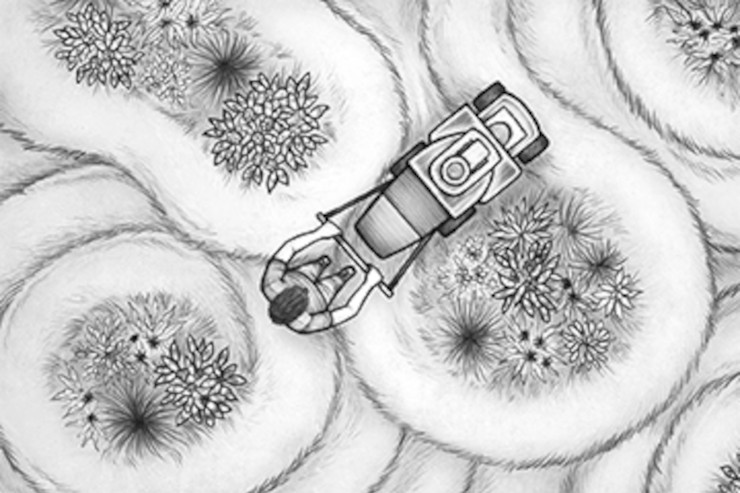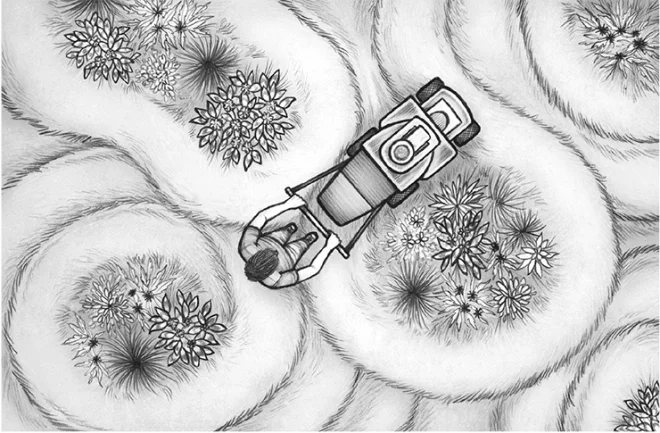
Today’s piece “Islands of Clover” gave me a good chuckle today, because it’s a story about a husband and wife, and a battle over weeds in the lawn that is just so opposite of my husband and I, but similar at the same time. In this story, the husband keeps leaving patches of dandelions and clovers in the grass while his wife struggles to comprehend why their yard is so icky next to their neighbors’ perfectly plucked and manicured yards.
You may have already guessed why: “the bees!” of course. In our yard, I let my guy have his lawn, he lets me have my garden, and recently he’s finally let me take to some of the once professionally mulched beds, where I’ve started planting crops of wildflowers and perennials. Weeding those beds has been a thorn in my side since we moved, so I’m hoping that over the next few years, I can plant enough flowers that they’ll crowd out the weeds, or at least mesh well with them. You won’t know until you try, right?
And also, like the story, I’ve noticed a bee problem this year, have you? My squash, which I planted in several locations in different soils and sun levels, have flowered but haven’t grown. I’ve grown about a thousand cucumelons though, so maybe the bees just prefer those flowers better, but I’ve definitely noticed a distinct difference in bee activity this year, and I’m curious if you have too.
What Do You Do With Weeds in the Lawn?
This story comes from our archive that spans over 30 years and includes more than 130 magazine issues of GreenPrints. Pieces like these that inject the joy of gardening into everyday life lessons always brighten up my day, and I hope it does for you as well. Enjoy!

Islands of Clover
Learning a different idea of beauty.
By Lorri Danzig
Andy had been mowing for at least an hour when I came out, balancing a basket of wet laundry on my hip, and breathed in the day. The air was thick with the sweet scent of fresh-cut grass. Damp with dew, it stuck to my sneakers. I looked out beyond the clothesline—and tried to make sense of the islands of clover and random clusters of dandelion left dotting our otherwise manicured lawn. My husband, an engineer, was deliberate and methodical. What the heck is he doing? I wondered.
Our neighbors’ properties were weed-free. Bushes were pruned and edged beds confined new rows of annuals. Our place, though, was a crazy quilt of a landscape. Rag-tag weeds and wildflowers encroached upon the lawn. Potatoes and garlic grew in the center of a mowed half-acre. The clumps of clover and protected stands of dandelion only added to the disarray. The memory of every oddball thing that Andy had ever done raced through my mind. I was aggravated, though I didn’t want to be.
Taking a deep breath, I turned my attention back to the laundry. I started hanging the sheets and towels—just as the roaring red engine of Andy’s push lawnmower rounded the house.
His tattered t-shirt, a relic from a father-son rafting trip, hung limp with sweat. Pausing, he gave his head a good scratch before heading across the lawn again. The mower left ribbons of freshly mowed grass in its wake. But then he stopped, dragged the mower backwards, and transcribed a circle around a stand of clover in the middle of the lawn!

I dropped the bag of clothespins and ran across the lawn, waving my arms and shouting.
“Shut the mower!”
He did. “What is it?” he asked.
“What are you doing?!” I said, pointing to the patch of clover. “It’s for the bees,” he said.
“What is?”
“The clover,” he said, as though that was explanation enough. “And the dandelions?” I asked, pointing to the yellow cluster of starbursts huddled by the pear tree.
“Oh, they’re just pretty.”
“The lawn looks ridiculous!” I said, my voice climbing.
Andy uncapped his water bottle and took a long swig. Then he spoke. “The bees are dying off, you know that,” he said. “Re-member last year—all those zucchini flowers and no zucchini? We need the bees to pollinate the garden. The clover will attract them. This,” he opened his arms to embrace the entire lawn, “isn’t ridiculous. It makes sense, and it’s beautiful. Just look.”
By long-standing agreement, the inside of the house is my domain and the outside is his. For that reason alone, I knew I should back off. And then I remembered…last fall I stopped at nearby Clover Nook Farm in Bethany, Connecticut for cider. As I had often done before, I dallied at the farmstand, comparing notes with the farmer’s wife.
“Back as far as I can remember,” she said, “when the eggplants were flowering and I would walk between the rows, the hum of wings, it’d be deafening. Not this year. Never heard so much silence.”
When I remembered those words, the fight went out of me. I looked up at Andy and said, “OK.”
It’s been a good three months since Andy and I tangled over his mowing. The tomato cages have been up-rooted, squash vines composted, and hoses stowed. I have had ample time to accustom myself to circumnavigating the islands of clover as I make my way to our vegetable garden. This morning, sweatshirt zipped and carrying a steaming coffee mug, I drag a plastic chair across the browning grass and set it down in front of a solitary aster. From where I sit, I can see the north end of our property hemmed in by mulberry, raspberry, and bamboo. Dried seedheads of milk thistle and echinacea add their own texture to the part cultivated, part wild tapestry.
Most of our suburban neighborhood, like the one I grew up in, is kept pristine by gardeners armed with hedge clippers and weed whackers. Andy’s sense of beauty, though, blooms from within, shaped as much by his values as by what pleases his eye. I have learned to cherish the tranquil setting Andy has nurtured and to appreciate the beauty he sees in an ungroomed world. I am slow to leave this spot, but with my mug drained and chores waiting, I head back to the house.
A spider has fashioned an elaborate web in the corner of the patio where a window joins the wall. Picking up a twig, I move in closer to clear away the sticky snare.
I look. Some light reflects off dew droplets in the web, casting an iridescent shimmer across its silken threads. At the center of the dazzling spiral, a golden orb weaver crouches in wait.
I open my hand and let the twig fall back to the flagstone. ❖
AUTHOR, published originally in 2016, in GreenPrints Issue #118. Illustrated by Kate O’Hara

Have you made any changes to the way you manicure your yard in recent years, to help out the pollinators? What do you do with weeds in the lawn? Let me know!




Wild is best. Around my house is a mix of natural wildflowers, volunteer trees, woodsy areas under towering, mature trees. The snake root attracts pollinators of the insect variety while the Rose of Sharon is the flower of choice for the hummingbirds. Next year, I’m adding perennial wild sunflowers for striking yellow color and variety for the bees. My neighbors have only grass so I feel responsible for helping our flying friends.